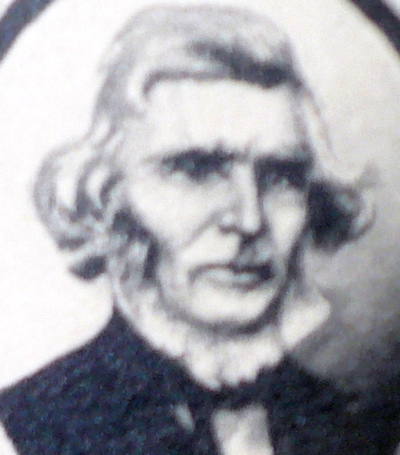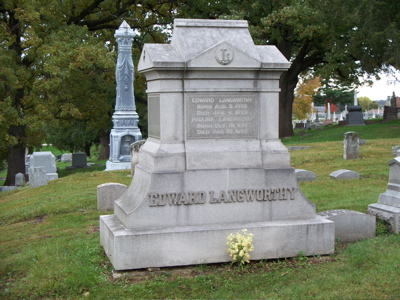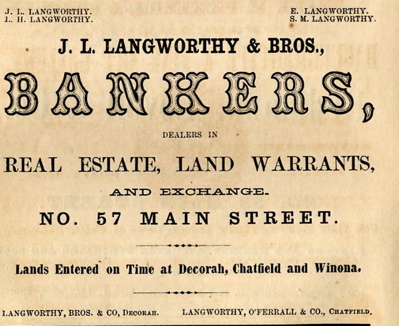Encyclopedia Dubuque
"Encyclopedia Dubuque is the online authority for all things Dubuque, written by the people who know the city best.”
Marshall Cohen—researcher and producer, CNN
Affiliated with the Local History Network of the State Historical Society of Iowa, and the Iowa Museum Association.
LANGWORTHY, Edward: Difference between revisions
No edit summary |
No edit summary |
||
| Line 2: | Line 2: | ||
[[Image:P1000296.jpg|left|thumb|150px|Edward Langworthy. Photo courtesy: Bob Reding]] | [[Image:P1000296.jpg|left|thumb|150px|Edward Langworthy. Photo courtesy: Bob Reding]] | ||
[[Image:edlang.jpg|right|thumb|200px|Gravestone in Linwood Cemetery]]LANGWORTHY, Edward. (St. Lawrence Co., NY, Aug. 3, 1808-Dubuque, IA, Jan. 5, 1893). In September 1832, Langworthy may have constructed the first house in the future state of Iowa. One of many eager miners of [[LEAD]], Langworthy and his brothers [[LANGWORTHY, James|James LANGWORTHY]] and [[LANGWORTHY, Lucius Hart|Lucius Hart LANGWORTHY]] were driven from the region in November of that year by soldiers from Prairie du Chien who had the responsibility of keeping whites east of the [[MISSISSIPPI RIVER]]. | [[Image:edlang.jpg|right|thumb|200px|Gravestone in Linwood Cemetery]]LANGWORTHY, Edward. (St. Lawrence Co., NY, Aug. 3, 1808-Dubuque, IA, Jan. 5, 1893). In September 1832, Langworthy may have constructed the first house in the future state of Iowa along West Locust. (1) One of many eager miners of [[LEAD]], Langworthy and his brothers [[LANGWORTHY, James|James LANGWORTHY]] and [[LANGWORTHY, Lucius Hart|Lucius Hart LANGWORTHY]] were driven from the region in November of that year by soldiers from Prairie du Chien who had the responsibility of keeping whites east of the [[MISSISSIPPI RIVER]]. | ||
[[Image:langworthybank.jpg|left|thumb|250px|Dubuque City Directory, 1857-1858. Photo courtesy: Bob Reding]] | [[Image:langworthybank.jpg|left|thumb|250px|Dubuque City Directory, 1857-1858. Photo courtesy: Bob Reding]] | ||
Langworthy returned to the Iowa side of the river in April 1833. He built several homes and many stores. Elected town trustee, county commissioner, and a member of the legislature for three sessions, Langworthy was also a member of the constitutional convention when he proposed to exclude "negroes" from the state and to abolish the grand jury system. Neither idea passed. Langworthy helped create a claims system for the sale of mineral lands which was adopted by the public land office. | Langworthy returned to the Iowa side of the river in April 1833. He built several homes and many stores. In 1836 he attended a railroad convention in Madison, Wisconsin and was an early advocate for constructing a railway from Lake Michigan to the Mississippi River. (2) Elected town trustee, county commissioner, and a member of the legislature for three sessions, Langworthy was also a member of the constitutional convention in 1844 when he proposed to exclude "negroes" from the state and to abolish the grand jury system. Neither idea passed. Langworthy helped create a claims system for the sale of mineral lands which was adopted by the public land office. | ||
As a city alderman, Langworthy helped establish schools, factories, and a street railway system. He supported street and road improvements. Members of the firm of J. L. Langworthy and Bros. were prominent. Following the financial panic of 1857-58, he became a stockholder and director of the [[FIRST NATIONAL BANK OF DUBUQUE]]. | As a city alderman, Langworthy helped establish schools, factories, and a street railway system. He supported street and road improvements. Members of the firm of J. L. Langworthy and Bros. were prominent. Following the financial panic of 1857-58, he became a stockholder and director of the [[FIRST NATIONAL BANK OF DUBUQUE]]. | ||
In 1856-1857, [[RAGUE, John Francis|John Francis RAGUE]], a famous architect, designed the Edward and Pauline Langworthy home which soon became known as the [[OCTAGON HOUSE]]. At the time of his death, Langworthy's personal assets totaled $170,000 making him the wealthiest of the brothers. (3) | |||
-- | -- | ||
Source: | Source: | ||
1. Gibson, Michael D. "Part II-Dubuque's First Family: The Langworthys," Julien's Journal, August 2013, p. 40 | |||
2. Ibid. | |||
3. Ibid. | |||
Hudson, David; Bergman, Marvin; Horton, Loren. '''The Biographical Dictionary of Iowa'''. Iowa City: University of Iowa Press, 2008 | Hudson, David; Bergman, Marvin; Horton, Loren. '''The Biographical Dictionary of Iowa'''. Iowa City: University of Iowa Press, 2008 | ||
Revision as of 02:06, 28 August 2014
Family History: http://wc.rootsweb.ancestry.com/cgi-bin/igm.cgi?op=GET&db=huppe&id=I48813
LANGWORTHY, Edward. (St. Lawrence Co., NY, Aug. 3, 1808-Dubuque, IA, Jan. 5, 1893). In September 1832, Langworthy may have constructed the first house in the future state of Iowa along West Locust. (1) One of many eager miners of LEAD, Langworthy and his brothers James LANGWORTHY and Lucius Hart LANGWORTHY were driven from the region in November of that year by soldiers from Prairie du Chien who had the responsibility of keeping whites east of the MISSISSIPPI RIVER.
Langworthy returned to the Iowa side of the river in April 1833. He built several homes and many stores. In 1836 he attended a railroad convention in Madison, Wisconsin and was an early advocate for constructing a railway from Lake Michigan to the Mississippi River. (2) Elected town trustee, county commissioner, and a member of the legislature for three sessions, Langworthy was also a member of the constitutional convention in 1844 when he proposed to exclude "negroes" from the state and to abolish the grand jury system. Neither idea passed. Langworthy helped create a claims system for the sale of mineral lands which was adopted by the public land office.
As a city alderman, Langworthy helped establish schools, factories, and a street railway system. He supported street and road improvements. Members of the firm of J. L. Langworthy and Bros. were prominent. Following the financial panic of 1857-58, he became a stockholder and director of the FIRST NATIONAL BANK OF DUBUQUE.
In 1856-1857, John Francis RAGUE, a famous architect, designed the Edward and Pauline Langworthy home which soon became known as the OCTAGON HOUSE. At the time of his death, Langworthy's personal assets totaled $170,000 making him the wealthiest of the brothers. (3)
--
Source:
1. Gibson, Michael D. "Part II-Dubuque's First Family: The Langworthys," Julien's Journal, August 2013, p. 40
2. Ibid.
3. Ibid.
Hudson, David; Bergman, Marvin; Horton, Loren. The Biographical Dictionary of Iowa. Iowa City: University of Iowa Press, 2008
Oldt, Franklin. History of Dubuque County, Iowa. Chicago: Western Historical Company, 1880, p. 827-828




